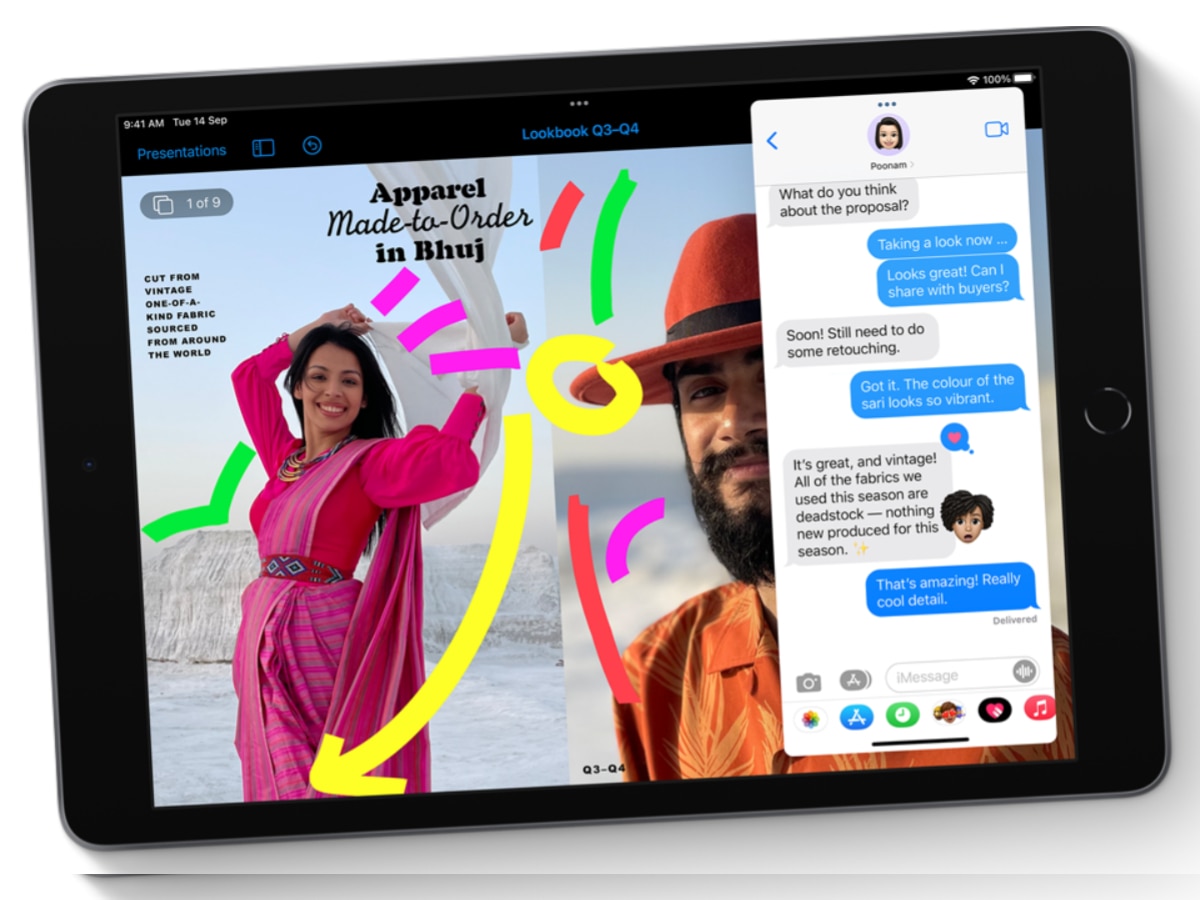iPad (10th Generation) Challengers: Three iPads And A Samsung Offering To Choose From
For the first time, Apple’s new iPad is in the line of fire of some of its own siblings.

In a very un-Apple way, the Cupertino tech giant recently released its new generation of iPads. Unlike most of the other launches by Apple that are preceded and succeeded by a lot of fanfare, the new iPads did not even get a dedicated launch event. But this does not take away from all the improvements that the new tablets bring along. While the Pro variant gets the heavy-duty upgrades, it is the base iPad (generally referred to as just 'iPad,' with no Air-y or Pro-fessional suffixes) which has been making most of the headlines and for good reason.
The vanilla iPad's price ain't as basic as before
The base iPad, which used to be the most affordable iPad and used to be priced in the vicinity of Rs 30,000, took a big price leap this year. And while it comes with a number of design and specs changes, the biggest change that has made many jaws drop has to be the price which has gone beyond Rs 40,000. While the iPad (9th generation), which was launched at Rs 30,900, has also received a price bump and is now officially available for Rs 33,900, the iPad (10th generation) takes an even bigger price jump and comes with a starting price of Rs 44,900.
The classic iPad, which until recently looked quite ancestral with thick bezels, a round home button under the display, curved sides, a tiny camera on the back and monochrome shades has now been modernised.
The tenth-generation iPad comes with thin bezels paired with a power/lock button which doubles up as a fingerprint scanner placed on top of the iPad, more contemporary flat sides that we see on the iPhones and newer iPad models, a big camera unit on the back and in poppy-peppy colour shades.
Apple has pretty much turned the design of the base iPad on its head. It also comes with Apple’s A14 Bionic chipset, the same processor which powered the iPhone 12 series, and comes with a bigger 10.9-inch Liquid Retina True Tone display, the biggest display ever on an iPad.
Apple has also changed the selfie camera’s location, placing it on the right vertical bezel or what Apple calls the Landscape Ultra wide front camera.
Gone, however, is the 3.5mm audio jack, something that was a staple on the base iPad earlier. The new iPad also gets a USB Type-C port which is a big yay when it comes to connectivity but as it still comes with support for first-generation Apple Pencil, one would have to buy a Type-C to Apple Pencil dongle (for Rs 900) to charge it.
Notwithstanding all these improvements, the new iPad perhaps faces more competition than any base iPad in the past, as its higher price tag opens the door for a different level of competitors and not just mid-segment Android players trying to keep up with the tab that rules.
In fact, for the first time, the iPad is in the line of fire of some of its own siblings. So, if you are looking to buy a new tablet and are considering the new iPad, here are a few other iPads and an Android tablet that you can consider.
iPad Air (5th Gen): Light-y and mighty
Price: Starting from Rs 52,000 (approx)
One of the biggest challengers that the new iPad has to face is its own Air-y sibling, the iPad Air (5th generation). While there are not many visible and spec-tacular differences between the iPad Air and the new iPad — both have similar thin bezel design, with the same sized display, flat sides, power/lock-cum-fingerprint scanner on the top, similar cameras in megapixel terms and similar battery life, the Air has a major ace up its sleeve – the processor.
The iPad Air is powered by the more powerful M1 chipset from Apple which has also powered the previous generation of MacBooks and iPad Pros. This not only means that the iPad Air will be able to handle even more strenuous tasks with ease as compared to the iPad but, also that it is likely to get updates for a longer period of time.
What's more, it will also get features and functions that may be exclusive to the M-line of processors. Another difference between the two is Apple Pencil support. The iPad Air comes with support for the second-generation Apple Pencil while the new iPad supports the older Apple Pencil. The second-generation Apple Pencil is better in terms of performance than its predecessor and comes with a dedicated magnetic charging space on the iPad Air itself, while you will have to buy a separate dongle with your new iPad to charge the Apple Pencil.
At 247.6mm x 178.5mm x 6.1mm and 461 grams, the iPad Air is also more compact but lighter than the new iPad.
Yes, it does cost a bit more than the iPad in official terms — its official price is Rs. 59,990 — but often comes with discounts and deals and can be available for as low as Rs. 50,000.
At that price, it gets right into the new iPad's territory.
iPad mini (6th generation): Mini but powerful
Price: Starting from Rs 45,000 (approx)
Another iPad sibling that is competing with the newly launched iPad is the compact version of the tablet, the iPad mini.
While some might completely dismiss the iPad mini for its comparatively small display size of 8.3 inches, it has quite a few things going for it.
For starters, the iPad mini comes with a better processor as compared to the new iPad — the A15 Bionic chipset which powers the iPhone 14 and iPhone 14 Plus, giving it a clear edge over the new iPad in handling heavy-duty tasks.
Apart from this, the iPad mini also comes with support for the second-generation Apple Pencil which has its magnetic dedicated charging station on the side of the iPad mini, something that is missing from the new iPad.
The iPad mini also brings the same cameras (which are easier to operate thanks to its smaller size) and even comes with the same battery life as the iPad, as per Apple.
And while some might grumble about the smaller display, there is no doubting that it makes the iPad mini handier and the most portable iPad of them all — you can slip it into your overcoat pocket.
The official price of the iPad mini is slightly higher as compared to the new iPad — it comes with a starting price of Rs. 49,900. But thanks to deals and offers on different outlets, you can get it for as little as Rs 45,000.
If you can put up with the smaller display, this is a very worthy alternative to the new iPad.
iPad (9th generation): The budget buddy
Price: Starting from Rs 30,000 (approx)
Usually when Apple releases a new iPad, it discontinues its predecessor. Interestingly, that has not happened this time around. This means that if you are looking for a powerful enough tablet but have a tight budget, you have the option to go for the 9th-generation iPad.
Yes, it comes with a retro design complete with big bezels, a round home button, curved sides and dull colours, but you still get a good display of 10.2 inches which is only marginally smaller than that of the new iPad.
You get a powerful-enough A13 Bionic chipset which is not as powerful as the A14 Bionic on the new iPad but will get you through most of your tablet-tasks without too much trouble.
Its 12-megapixel selfie camera runs its counterpart on the new iPad close (although it is located more conventionally near the top of the display), although its 8-megapixel sensor on the back is not quite as good as the 12-megapixel snapper on the new iPad.
It also has a Lightning port which might be a connectivity curse for some but saves you from the need of buying a separate dongle to charge the Apple Pencil. And audiophiles will love the fact that it comes with a 3.5mm audio jack.
With an official (recently jacked up) starting price of Rs. 33,900, the iPad (9th generation) remains the most affordable iPad around and with the right deals and discounts, is often available for Rs 30,000 or even lesser.
In fact, you can even get a Wi-Fi and cellular version of it at some outlets for less than the price of the Wi-Fi-only version of the new iPad.
In many senses, it still remains the real base iPad, even though its successor has arrived. It may not look as modern and might give ground on some spec fronts, but it just works, supports the Apple Pencil and comes with a price tag that is far below that of its shiny, sleek, straight-sided and colourful successor.
Samsung Galaxy Tab S8: The sole Android ranger

Price: Starting from Rs 50,000 (approx)
If your heart desires a tablet that is not plucked from the Apple tree then you can opt for this capable Android tablet from Samsung.
The Galaxy Tab S8 was launched earlier this year and comes with some very powerful specs and features. It features a big 11-inch LCD display with a better pixel density of 274ppi as compared to the new iPad, and is powered by Qualcomm’s flagship smartphone processor, the Snapdragon 8 Gen 1 which is considered superior to the A14 Bionic, and is capable of handling all things power-hungry with ease.
You have the option to choose from 8GB and 12GB RAM options with 128GB and 256GB storage options.
Unlike the iPad, you can expand the storage on the Galaxy Tab S8 all the way up to 1TB using a microSD card.
The tablet also brings an extra camera on the back as compared to the iPad and comes with a dual camera setup comprising a 13-megapixel main sensor and a 6-megapixel ultrawide sensor. At the front there is a 12-megapixel selfie snapper.
An 8,000mAh battery delivers ten to twelve hours of battery life, which is very iPad-like, and also comes with support for 45W fast charging.
There are stereo speakers for great sound, but alas, no 3.5mm audio jack.
We left the best for last — the tablet comes with Samsung's famous S Pen stylus, which means you can make notes and scribble on it effortlessly without having to purchase a stylus separately (something you need to do with the iPad).
The only drawback for the tablet is the fact that it runs on Android which still seems more optimised for mobile phones than tablets. It comes with Android 12 out-of-the-box and in pure spec terms is an excellent alternative to the iPad.
With a starting price of Rs. 50,999, the Tab S8 definitely sits at the pointy end of the scale but then it brings a lot of power and some added features as compared to the iPad.
Enough to make it the lone Android ranger going up against Apple's mighty tablet.
Related Video
Apple creates a new record in iPhone sales after launch of iPhone 16 | ABP Paisa Live





































